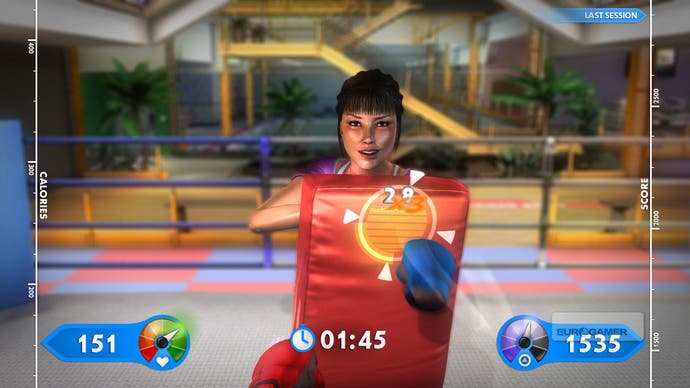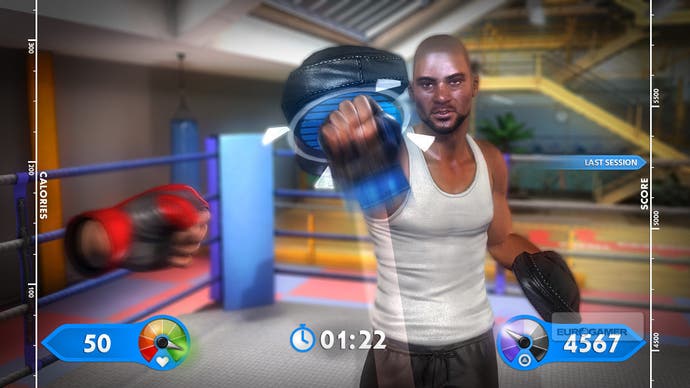Move Fitness Review
Going through the motions.
Move Fitness is Sony's first foray into the increasingly crowded digital gymnasium Nintendo opened four years ago, when Wii Fit first started upsetting fat people by pointing out they were fat.
The best fitness games aspire to be four things at once: a stepping-stone, a supplement, a motivator and a distraction. They're not meant to be a replacement to 'normal' exercise, which is the usual assumption of habitual point-missers.
You may want to do something about the terrible state of your personal fitness - or, indeed, fatness - but the step from slobbing on the sofa to sweating in an all-too-public gym is considerably bigger and more daunting than the one to the fridge for another sausage roll.
A game can take the sting out of this, getting you up-and-active in private, gradually building confidence so you might eventually make it into the pool rather than the pie shop. And if you already exercise, a game can give you a proper workout on those days when you can't be bothered to go to the gym or it's pissing it down outside.
But the real genius of interactive fitness is in personalising the experience and giving proper, realtime feedback on your workout - so the game isn't just a virtual gym, it's also a virtual personal trainer: a crucial difference. And if it can do all of this while tricking you into thinking you're having fun rather than in actual fact sentencing your body to days of aching misery, you're onto a winner.

So where does Move Fitness, er, fit into all of that? The game's simple but elegant concept is to use two Move controllers (be aware that you can't play it with just one) so they effectively become your arms in the game.
The accuracy of Sony's motion controller lends itself brilliantly to the genre in theory. Which is why, as someone who has now tried more fitness games than is sane, I was genuinely excited to put it to the test after seeing it debut during Sony's Gamescom press conference.
In practice, at its best, it can be a great success. One exercise has you holding a net with which to catch balls that are fired towards you. You have to hold the two Move controllers at a set width as if you were doing it for real, which had me jumping all over the shop trying to pluck imaginary objects out of thin air.
In the sparring exercise, each controller corresponds to a fist for blows, and because the PlayStation Eye is tracking them, you can quickly and accurately dodge left and right and duck punches from your sparring partner.
Similarly, in basketball, you move left and right, crouching and pulling both triggers to pick up the ball, before standing, jumping and releasing the triggers to fling it at the basket.

This sort of stuff is exactly what I was hoping to see in the game: a convincing blend of responsiveness, exertion and entertaining distraction. Which, sadly, only serves to heighten my frustration at what might have been in what is ultimately a lazy and superficial missed opportunity.
The biggest fault is the lack of content. Move Fitness comes with a limited 28 activities - compared with EA Sports Active 2's 70, for instance. And a good number of those are simple variations of the same exercise.
I appreciate the game is being sold at a budget price point, but budget content does not suit this genre. It's rarely a good sign when I become bored of the very first routine I attempt through sheer repetition of exercises.
Routines are divided and named according to a specific goal, e.g. "Strong Shoulders", "Fat Burner" and "Beach Body", and you're given an indication of which parts of the body are being targeted most as a percentage. It's all pretty vague, though.
You can also select how long you want each routine to last, although lengthening merely multiplies the existing exercises rather than adding any useful variety. Your progress is tracked via graphs, stats and online leaderboards, and pretty much everything you do is tallied. But what the development team has failed to fully realise is that this is only truly useful if the game provides sufficient motivation to keep going, because it is not enough in itself.

The original EA Sports Active's standout feature was the 30-Day Challenge: a month-long workout programme designed specifically to give you a reason to keep coming back, with realistic targets, good variety and the promise of measurable improvement at the end of that month.
The absence of anything similar in Move Fitness is baffling. Instead, the game has "Goals", which, rather than providing meaningful motivation, are seemingly an arbitrary selection of largely unappealing tasks. Today's goals for me, for example, are: beat my high score in an activity; play another activity multiple times; beat a particular overall score. If it isn't personalised, I'm not motivated. And if I'm not motivated, I'm not interested.
It's a shame, because there are some really good ideas in here. I particularly like the progress tracker on the right side of the screen, which, during an activity flags up bonus markers, or whatever your previous best is, which really does make me push myself that bit harder.
But elsewhere the evidence of a lack of thought and effort is all too evident. A virtual trainer is on screen during many activities, showing the correct form that you should be mirroring. But this just loops endlessly, regardless of whether you are in time or not, with the frequent result that it becomes not a help but a distracting hindrance.

What I do have praise for is the simplicity and cleanness of the interface and menus, which are painless to use - a sad rarity in motion-controlled games - and calibration is very quick and very easy.
Move itself, as I've already mentioned, works great - it's simply the content that lets it down. What it can't do, though, is track your legs - so it either assumes you are crouching based on the position of the controllers in your hands, or trusts you to do the exercise properly and not cheat. (As an aside, this is where Kinect would have been expected to destroy Wii and Move, but so far only YourShape has done a decent job of exploiting it).
Move Fitness has made me sweat buckets and, at times, completely forget I'm exercising as I'm so focused on the game itself. But due to the weak structure and thin content, too many activities feel more like random tech demos rather than an integrated part of a thoughtfully constructed fitness title.
The game sums up for me Sony's general approach to Move so far: it's all so half-hearted. Compared to the ridiculous song and dance Microsoft made over Kinect, Sony has barely made any noise about the brilliant potential of its motion-controller. It's finally starting to invest in marketing, but it also needs to invest more in development. As a general rule of thumb, a 'will this do?' attitude generally won't do at all.
I really, really hope the developer gets a second crack at Move Fitness, as the core concept clearly works and there are some screamingly obvious things that, if added, would make the game a much better, potentially excellent, fitness game. But as it stands, what should be Mr. Motivator is very much Mr. Average.

